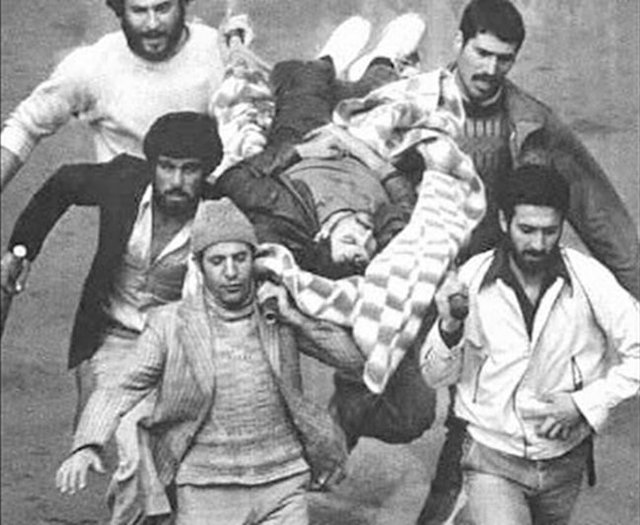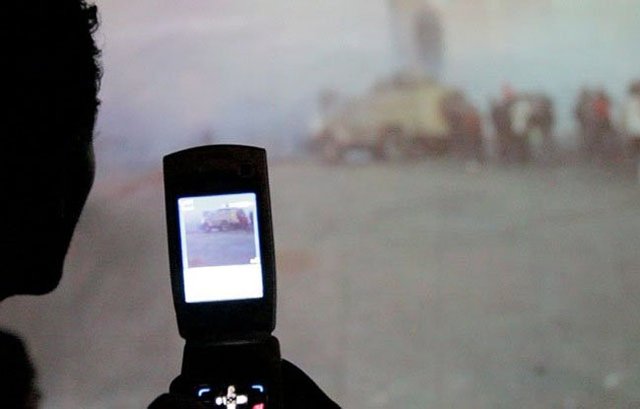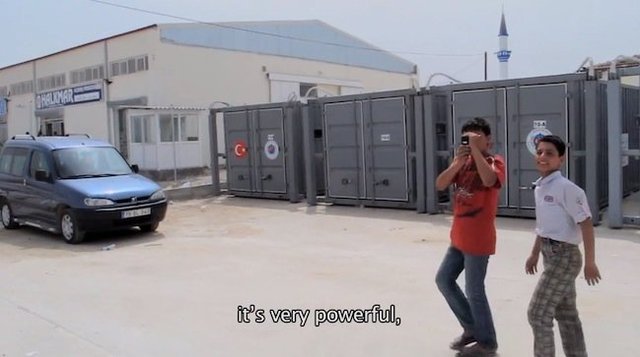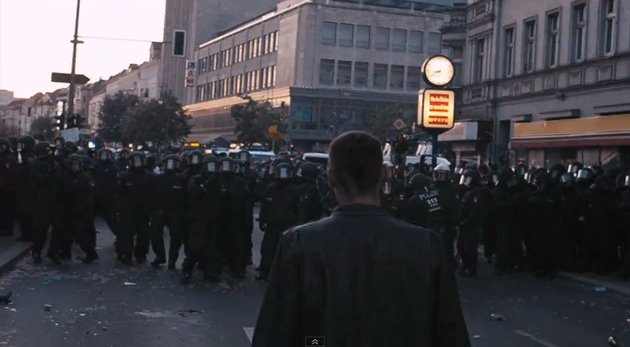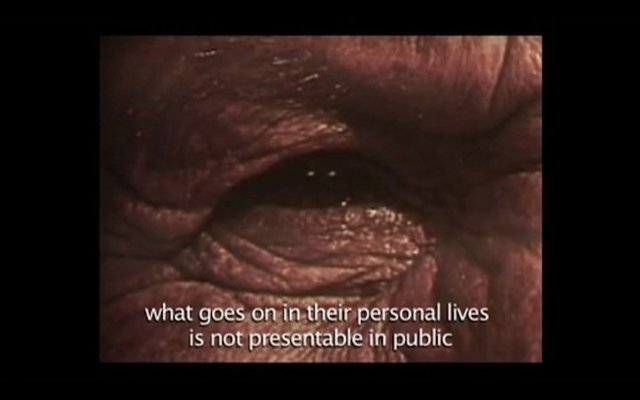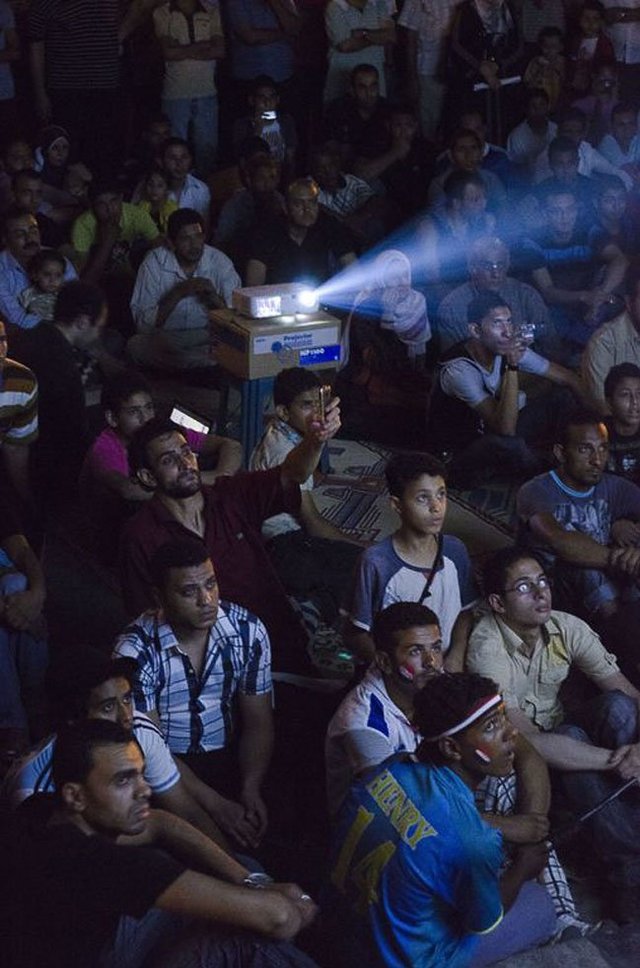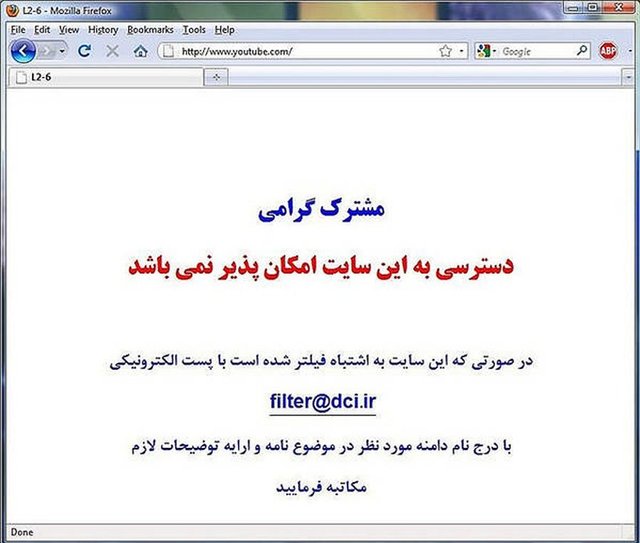Essays
Citizens Reporting and the Fabrication of Collective Memory
Citizens Reporting, A Collective Memory[1]
'We use our hands for better or for worse, we strike or stroke, build or break, give or take. We should, in front of each image, ask ourselves the question of how it gazes (at us), how it thinks (us) and how it touches (us) at the same time'.
Georges Didi-Huberman[2]
Flipping through the pages of one's memory over the past four years, we stumble upon an array of random 'revolution' imagery. A picture book that loosely lumps together clouds of visual material without clear equation between frames of reference or origin, from the Iranian Green Movement and the various uprisings within the Arab world via protesters at the periphery of the Eurozone to different Occupy movements spreading around the globe.
This certainly has to do with the effects that new media technologies have on collective generational perceptions and how memory at large is fabricated. Social media and Web 2.0 played an important role during the unfolding of events in the Arab world, and so they served the self-organization and growth of movements such as Occupy. But this alone does not suffice to draw up coherent threads that link the various social movements and events under the aspect of one collective and ongoing global uprising, as many journalists, writers, curators and scholars have tried to do recently. The 7th edition of the Berlin Biennale earlier this year exemplified this with an abstrusely arbitrary choice of videos compiled into a multiple-screen installation on the uppermost floor in the Berliner Kunst-werke.
This essay focuses on a third element playing into this aspect: the rise of new forms of reporting that emerged in response to recent moments of crisis, social change and political struggle. One key concept that shifted the circulation of events across various media platforms since 2009 is citizen journalism. The term was coined to label all non-professional, non-governmental media coverage, one that manifests 'on the ground' from a position of witnessing. With the rising popularity of citizen journalism, the formal lines between journalism and other professional fields blur as people from different backgrounds became the reporters contesting censorship and attempting to restore transparency across media channels. Citizen journalism's crucial role also cranked up the impact that alternative forms of reporting have had on aesthetic discourse at large, as it continues to reshuffle the dynamic relations between notions of citizenship, social awareness, historiography and collective memory.
The following essay will give a three-way perspective on these issues, starting with an introductory overview of the current status of citizen journalism in the Middle East, with a particular focus on Egypt, and its strife with state-controlled and corporate media. This is followed by ruminations on the potency of new forms of reporting and the alterations of proximity and distance these create within aesthetical and political discourse at large. The last chapter extends these reflections into a wider context, expanding the notion of civic reportage and bringing in two examples from an aesthetical and an historical perspective.
Opposing the state-controlled
National media coverage in Egypt often side-steps such polemical content as human rights infractions or criticism of the authorities. Alternatively, they present such subject matters within a framework that rejects its cause or imposes its threat on the state's sovereignty. For example, they were found broadcasting footage of the violent clashes during the first 18 days of the Egyptian Revolution and framing protestors as armed thugs. In response, citizen journalists provided their own personal accounts, describing their real-time experience of the same event. People now share their stories in opposition to the information distributed through national media sources to bring forth a multitude of readings of a situation and to offer a more holistic capturing of current events. This is the very reason why this moment in time may be referred to as the 'Arab Awakening'.
Throughout the Middle East and North Africa, it can be noted that the roles of the media and the Internet, but also that of public space, have been slowly changing over the past decade. After years of state-controlled media and communication, there has been a major disconnect between the actuality of an incident and public knowledge. This void of non-biased information has therefore inspired creative routes to freely expressing thoughts, opinions and facts. A flood of voices, bravely exercising their freedom of speech within these social spheres, strives to prove or negate events emphasized or concealed within daily news. Although uncategorized and chaotic in chronology, they have proven effective in disseminating information amongst a growing number of people. National media still has the greatest reach, as the majority of populations in countries such as Egypt and Syria do not have access to international news channels or the Internet. Censorship and infiltration of the information disseminated amongst the masses has yielded an increase in blogging, anonymous reporting and the birth of initiatives and international grants aiding in the development of freedom of expression in the region. All these efforts aim to ensure the documentation of this transitional period includes a spectrum of accounts, giving a more comprehensive narrative of this historical moment in Arab history.
New media technologies have facilitated easier routes to communication and hence faster means to mobilizing large numbers of people, making it more difficult for the state to control and patrol online conversations and the like. In their latest 2012 evaluation, Reporters Without Borders have listed Syria, Bahrain, Iran and Saudi Arabia as 'Internet enemies', due to their censorship of online content and movements to detain bloggers for participating in anti-government discussions.[3] In Syria, social networking sites were banned for several years, although Internet users were able to access Facebook by tampering with Internet proxy settings. The ban was lifted in 2011, most likely to help the state police Internet activity and follow activists, as opposed to allowing them to lobby underground. Many bloggers gained a large following by sharing their political opinion and testimonies of events; readers have legitimized their words and labelled them as a reliable news source. Countless stories of Arab bloggers being tortured, detained, and/or put in front of military courts stain a decade's worth of news from countries like Egypt, Tunisia, Bahrain, Saudi Arabia and Syria. But this only confirms the threats they pose to oppressive regimes and their effectiveness in informing local and international publics. Activists continually find ways to fill in the information gap; others, in support, distribute this data in the public arena, to include an otherwise inaccessible segment of society in the information's life cycle.
The urgency of supporting civic reporting has inspired the beginnings of numerous initiatives. Menassat, a platform based in Lebanon, offers uncensored news from the MENA region whilst supporting and empowering Arab journalists. AltCity and Wamda provide training, financial support and spaces for discussions concerning media development. Meedan, founded in 2005, is another platform that tightens the information gap between citizens in the Arab and western worlds. The forum uses Machine Translations for all news stories and commentary uploaded onto the site, making citizen journalism accessible to readers in either region. Additionally, CheckDesk, a blogging tool used to report local news immediately (now used by Al Masry Al Youm newspaper in Egypt and the Syrian collective Al Ayam) are being designed and introduced by such initiatives.
Various collectives have sounded their voices for a specific cause. The Kazeboon (Arabic for 'liars') or 'No to Military Trials for Civilians' campaigns are branded to catch the common viewer's eye, and emphasize the Egyptian public's strife with specific issues. Their presence in the public sphere serves as a reminder of this constant battle and reserves a permanent space in every spectator's mind by providing missing information regarding an array of events relative to their cause, in these cases the injustices endured under military rule. The consistency of their visual branding holds them accountable for disseminated information, and somehow legitimizes it. These efforts unfold by attracting media attention, making it difficult for the accused to bypass consequences for unconstitutional acts and forcing the judiciary system to hold authorities responsible for injustices. This, in turn, will change the way history is written – or rather ensure the inclusion of voices on the ground when documenting history.
In Syria, a far more tense and dangerous environment today, citizen journalists are taking greater risks for a more urgent cause, which is to occupy a space within the general flow of news to illustrate the otherwise unimaginable means to which their oppressor grapples with his position of authority. In addition to being reporters, here citizen journalists assume a performative role whilst capturing the moment of their own deaths on camera.[4] This transition in purpose experienced by Syrian protestors/civil journalists, transforms viewers into witnesses of these events and gives them access to information that is otherwise concealed by Syrian state-controlled media.
In a constant battle, activists have gained agility in bypassing government-designed obstacles to sharing their experiences. No doubt corruption still exists, and at this moment in time it prevails. But with a strong continuity of citizen journalism, a corrupt system will eventually collapse during processes of forced change, starting from the ground up. How then does one decipher amongst the voices that suddenly occupy virtual and/or physical spaces in our lives? Surely, we are in a moment where a new form of spectatorship is adopted to better understand and record the reality of this historical moment to carry it through to the future.
Altering proximity and distance
When live broadcasts of precision-guided missiles entered home television sets during the Gulf War in 1990-1991, this clearly marked a turning point. The technocratic and machinic character of its imagery created a distance between the spectators and the places where the events took place, a proximity that paradoxically distances its viewers from the cruel facts of war. That same distance collapsed on the 11th of September, 2001, when masses of eye witness reports, mostly shot by private individuals, took over global news coverage for weeks to come, depicting the ongoing events in almost real-time. US media replied with embedded journalism during the 2003 invasion of Iraq, to display the military response to the world and concurrently reestablish that close distance. With the advent of social media sites a few years later, acts of reporting and public accounts continued to render new qualities, in terms of formal and investigative aspects as well as in terms of mobility, anonymity and connectivity. The Web 2.0 propelled this aspect further by liberating bloggers from any censorship and filters applied by traditional mainstream media, making it possible for an alternative reportage to circulate freely. This altogether altered the status of eyewitness reports within mainstream news coverage, a field highly guarded by professional journalism and its protocol. Moreover, it perforated the credentials of the journalistic traditional value system, inserting a new quality of speaking truth from a position of 'being on the ground' against the distant position that professional journalism takes due to its ethics and conventions.
These alterations of proximity and distance indicate how new forms of reporting like citizen journalism condition new forms of spectatorship. But what do these new forms of reporting demand from us as spectators, readers and publics? To what extent do they develop along the same lines as the engendering forms of reporting? And what are the risks and side-effects between those lines?
Let's start with the adverse aspects. With a growing amount of sources feeding into the network from a growing number of possible places, it has become difficult to trace the specific characteristics of origin, authorship and authenticity in what one gets to see and hear on various levels simultaneously. Threatened by repressive regimes and their persecution in a digital age, authors want to stay anonymous, their sources untraced. This poses a problem insofar as the veracity of even the eyewitness report is not guaranteed anymore, and the collective public at times loses the ability to distinguish between the feigned and unfeigned document. In the whirlwind of images generated, in particular during times of crisis, disconnected from their sources, one easily loses any sense of orientation.
At the same time, the material characteristics of civic and amateur reportage have long since been adopted into the language of other fields of aesthetic practice. Inconsistent framing, handheld camera and pixelation, to name just a few formal aspects, are now common stylistic elements in mainstream cinema, advertising and contemporary art. The accuracy of images with regards to their origin and intent has been blurred, and with this comes an immediate impulse to trust their superficial appearance. We feel reminded of Walter Benjamin's notion of aura, with which he describes the quality of artworks to produce a strange web of space and time; a distance, as close as it can be.[5] For Benjamin, this aura was in imminent danger of being destroyed by the technological progress of film and photography-based media, causing a shift that would strongly affect the social function of media at large. Today's image production and reproduction have reached dimensions that would have exceeded Benjamin's imagination at the time. Reading Benjamin slightly against the grain of his intention today, one could see in citizen journalism and its manifold facets a strange web of proximity and distance that is again at risk of being undermined by technological advancement – or its wrong application. Whether or not these concerns should outweigh the social and political agency of the imagery itself is evidently a complex issue.
Equally evident is that this has caused the aesthetics of protest and resistance to undergo transition and puts them at risk of being co-opted into other contexts where they easily become stripped of their critically informing essence, when street protest imagery becomes a selling point for a pair of jeans, for instance. But in contemporary art too, activist strategies are all too often brought into play but not paired with the necessary time and engagement to achieve the alleged impact on the ground.This has been fequently the case in post-revolutionary societies, such as Egypt. Which is why we, as authors working within the context of contemporary art, within the region, see a growing need to give thought to these risks and demand heed and precision with regard to these circumstances.
These shifts, legitimized by the underlying sense of social and political urgency, while at the same time fragmented by the larger complexities of visual culture, affect the formation of different collective subjectivities, whether in close proximity to the events depicted, or at a far distance. Here, again, the notions of distance and proximity are crucial to understanding how they affect the formation of the collective subject on either end. Between the two sides, geographically speaking, we can discern a dividing line drawn between notions of immediacy, of being on the ground, on the one side, and a discursive abstraction, drawing extensively on aesthetic concepts and theoretical analysis, on the other.
'Do we have something in common or not?' Syrian filmmaker and producer Orwa Nyrabia asked the Berlin audience during the 'Citizens Reporting, A Collective Memory' conference in August, 2012. His question seemingly addressed the apathy within western political discourse towards the ongoing cruelties of the Assad regime against Syrians, and the responsibility that the western political apparatus constantly neglects, denies and delays with regards to the situation in Syria. But Nyrabia actually directed his question to the audience, asking them to take up responsibility, and ideally action, in the most literal sense. How can one be engrossed in an intellectual aesthetic discourse when such real events take place, instead of thinking about how to organize a form of true and active engagement?
Nyrabia's question is marked by that same line of division between the immediate urgency of current events and their discursive abstraction, a line that seems impossible to overcome. At the same time, the immediacy shared through citizen journalists' reports constitutes a connection point that overcomes geographical distances. As such, it simultaneously constitutes and divides the realm of social and political engagement with the events taking place. This two-sided effect of citizen journalism on the political realm alludes to the concept of political difference, which demarcates the distinction between the realm of politics – pertaining the organization of politics, governments and institutions of state – and the realm of the political, pertaining the nature of politics and the political dimension of the social.[6]The realm of the Political is in close proximity to politics but operates at a distance from it. While the realm of politics itself may not offer the citizen any possibility of direct engagement with an existing conflict at a distance, the realm of the Political, distant but not detached from reality, can still provide space to engage with it indirectly without being apolitical. Reflecting the open political process of how such an engagement unfolds, Nyrabia's question encapsulates that precise political difference in itself.
Thus, his question suggests less a matter of overcoming this divide to arrive at collective action but instead of how to embrace it and how to use its marking points to explore what distinguishes politics from the Political, what constitutes political difference on either end. This can then become a vantage point from which to think about strategies for public debate and action beyond antagonisms of immediacy and distance, urgency and apathy, politics and aesthetics, activism and art. In a society whose citizens are placed at a distance to a certain location of conflict, a form of reflection that abstracts this conflict is essential in order to politicize it within its own realm of the Political. Now, to turn it around – is this also the case when in close proximity, when speaking from within the reality of such inconceivable events as in Syria today? On many occasions, writers, activists, filmmakers, scholars and artists have discussed what it means to write fiction in times of crisis and conflict, whether or not it is appropriate to delve into imagination and literary abstraction when surrounded by such a horrible reality. In a recent article in The National, Faisal Al Yafai addressed this question via the Egyptian writer Ahdaf Soueif, who speaks of her own dilemma as an author mostly dedicated to fiction writing, saying that one cannot suspend fiction writing and wait for a conflict to end, for a moment when history is complete and then resume. Conversely, it 'is through fiction that a greater understanding can be reached, precisely because it is distanced'.[7]
Enunciating the Batin (inner)
Various activist and artistic practices may serve to demonstrate how a fictionalization of reality, however temporary or formal it may be, can open up and inhabit a political realm that is similarly characterized by a notion of close proximity. We will look at two epitomizing examples from two different moments in history, analogizing them so as to arrive at a wider understanding of citizen journalism and how it can operate within aesthetic discourse at large. One is Tahrir Cinema[8], a series of public screenings organized by the Egyptian collective Mosireen in Tahrir Square in Cairo during the Egyptian revolution in 2011. The other is the short film First Case, Second Case[9] by Iranian filmmaker Abbas Kiarostami, shot around the time of the Iranian revolution in 1979 and finalized in 1981. Both Tahrir Cinema and Kiarostami's film are gestures that somehow fictionalize reality, if only for a moment in time, to apprise the subjective position of the spectators toward the social and political reality surrounding them. What connects both examples is the aspect of projection, both in the cinematic sense – of a cinema that moves images and emotions when events on screen seem at once immediate and out of reach – and in a time-related sense of projecting an event into the future or the past.
Shortly after its premier, First Case, Second Case was banned by the Iranian authorities and was considered lost for almost 30 years until it reappeared as a digital file on Vimeo and You Tube in June 2009, during which the Iranian Green Movement was on the rise and the sociopolitical transformation at its peak. Although the preliminary intention for making the film was different than its current form, this fictional film brought to light a reality within the Iranian mindset at the time that was otherwise concealed by mainstream media depicting the post-revolutionary period and during which the Islamic Republic filtered out all opposition parties that were involved in the 1979 revolution.
The film sketches two cases of a situation, hence the title, and calls for taking a moral position on either side. It starts in a classroom when silence is disrupted by a student in the back row every time the teacher turns his back to the students. After several warnings to the unknown student, the teacher suspends a group of suspected students from class for a week, under the condition that they may return if they reveal the identity of the misbehaving student. The narrative perspective shifts as the frame pulls back, showing the same scene as a projection on a screen with a person watching it. An extra-diegetic voice proposes two solutions: in the first case, the students remain silent and accept the collective punishment. In the second case, one of them denounces his fellow student to the teacher and is allowed to resume class.
What follows is a series of interviews and conversations with various people who have contrary opinions about the situation, their responses being mostly evasive and defensive at first. As the film moves on, the responses become more decisive when the question is extended to a variety of public figures, among them politicians, religious leaders, filmmakers, activists, artists, actors, poets, and educators. Interestingly, many of them are well-known today, as some grew to build a career within the Islamic republic while others were arrested just a year later due to their political positions; some were taken to the courts or put to death.
Kiarostami's film stays unbiased; it does not re-narrate incidents taking place at that time; nor does it use any political grammar in the manner of propaganda. Instead it depicts the mindset of a group of people from various sects of Iran's political spectrum, challenging the interviewees as well as the spectators to project themselves into a certain place and time, and the consequences of their position in the future. Almost 30 years later, in 2009, the film intervened in a similar way in Iran's socio-political processes. Distributed widely amongst politicians, intellectuals, artists, and activists as part of the Green Movement, the film helped them reclaim the 1979 revolution by understanding how and why the revolution took on a problematic path. When Iranians watched it in 2009, as witnesses to post-revolutionary Iran, they experienced the meaning of their own positions within their present, within the Green Movement, within that collective urgency, while becoming sensitized to the political dimension of that present. Prepared to document a moment in history just before a shift in the socio-political situation in Iran, Kiarostami lent his skill as a filmmaker to the collective eye in a similar way that citizen journalism does today. Though Kiarostami mediates his message through artistic prose, both can be considered to manifest present realities through the framework of a non-standardized form of journalistic practice.
Back to the recent past. The Tahrir Cinema events organized by alternative media collective Mosireen in 2011 were a kind of citizen journalism cinema. They provided open platforms for citizens occupying Tahrir Square to share and receive information, projecting video-documentations shot by citizens participating in events, demonstrations, sit-ins and clashes on the square and elsewhere in Egypt. Characterized by an aesthetic mode of cinematic architecture that aims for a socio-political goal, Tahrir Cinema turns the French cinéma militant tradition of 1968 into a cinéma civil in the most literal sense: a 'cinéma civil' that relates to public life and is directed by the collective eye of the civis, the citizen, against the belligerent opponent surveying and projecting the acts of the police and military against protesters on the streets, to ensure they are not unseen.
The potency of these collective cinematic moments was unshackled by the shared emotional and psychological experience of the same site. The screenings transformed the square into a cinematic black box, a Kairos,[10] elevating vision and imagination. The nightly spectators, demonstrators during the day, analogized their own experience of events with the images projected and the immediate experience of the site itself as being mirrored on the screen. In this moment, both the site and the spectator are shifted into an aesthetic realm that turns the square into a stage of semblance, enabling the identification with the protesting self of the citizen and its subjectivity, which had been denied within public spaces for at least 30 years under Hosni Mubarak. This existential moment of identification acted upon the collective memory and as such 're-awakened' a constitutive element of both the collective notion of citizenship and the public sphere.
Mosireen Collective's Tahrir Cinema and Kiarostami's First Case, Second Case have two things in common: both can be considered alternative forms of reporting in the sense that they intervened in the hegemonic order of history and the fabrication of collective memory in the present moment. Both enunciate the Batin (inner) of an event instead of representing its Zahir (outer), even though they apply very different means. The Tahrir Cinema events projected the site and its spectators onto the screen. Kiarostami's film revealed the social and cultural psyche of post-revolution Iran in 1979 by projecting the collective subconscious of the Iranian society onto itself, and from the past into its own future.
As a matter of coincidence, Kiarostami's film itself was 'projected' into the future, travelling through almost three decades. When Iranian censorship prohibited its public distribution, the film disappeared and had since then been nearly impossible to find, even for avid film lovers, until its timely reappearance in 2009. And as time would tell, it did not lose its urgency on that journey. Breaking down a historical gap of nearly 30 years, the unremitting relevance of Kiarostami's film as a document of collective memory underlines the desire of many Iranians to not let history repeat itself. The film, however, did not reappear by itself. It was reloaded into the present, in an act of citizen journalism, by citizens who made the film accessible to a wider audience they knew would benefit from this documentation of realities through the new media tools they have at their disposal.
As citizens all over the world grasp the means to which they may share perspectives on current events, their original practices, whether they be artists, filmmakers, political analysists or cultural producers of any kind, then serve as a skill with which they enhance the content or frame of new forms of reporting and how they affect collective memory, history in its making, and the newly-acquired rights to the public sphere. Citizen journalism today has gained an accountability and legitimacy that wasn't included within the general flow of news. It is within these frames that spectators gain an utterly different perspective on current events. And it is within these accounts that a collective memory of historical moments gains a comprehensive quality, unlike that of the past.
[1] This collectively-written essay is inspired by the authors' shared experience of organizing 'Citizens Reporting, A Collective Memory', a conference in Berlin in August, 2012, bringing together a group of speakers from various geographical and professional backgrounds, including journalists, filmmakers, artists and other cultural producers from Egypt, Iran, Syria, Germany, and the US. The conference merged many ideas that manifested themselves simultaneously in 2012, at a time when the political situation in the Middle East was different than it is now. It was primarily sparked by a wish to respond to the misrepresentations of the Arab uprising within the media and artworlds, among other things the 7th Berlin Biennial and its provocative modes of dealing with aesthetics of protest and resistance. The conference had no intent to speak from a position that memorizes revolution as one or multiple events but instead reflect on how certain events are mediated and represented to become part of a collective memory. In this sense, it contemplated a collective report that acts upon a memory that is in the making as we speak – or write.
[2] Georges Didi-Huberman, 'How to Open Your Eyes,' in Harun Farocki – Against What? Against Whom?, eds. Antje Ehmann and Kodwo Eshun (London: Koenig Books, 2009), 39.
[3] 'Beset by Online Surveillance and Content Filtering, Netizens Fight on,' Reporters Without Borders, 13 March 2012 http://en.rsf.org/beset-by-online-surveillance-and-12-03-2012,42061.html
[4] Jon Rich, 'The Blood of the Victim: Revolution in Syria and the Birth of the Image-Event,' e-flux Journal 26 (2011), trans. Bechara Malkoun and Rebecca Lazar http://www.e-flux.com/journal/the-blood-of-the-victim-revolution-in-syria-and-the-birth-of-the-image-event.
[5] Walter Benjamin, 'A Little History of Photography,' in Selected Writings, Volume 2 (Cambridge: Harvard University Press, 1999).
[6] Oliver Marchart, Die Politische Differenz – Zum Denken des Politischen bei Nancy, Lefort, Badiou, Laclau und Agamben (Berlin: Suhrkamp, 2010).
[7] Faisal Al Yafai, 'As Regimes Arrest Artists, their Art Explores Arab Uprisings,' The National, 4 September 2012 http://www.thenational.ae/thenationalconversation/comment/as-regimes-arrest-artists-their-art-explores-arab-uprisings.
[8] Mosireen, 'Our Story,' Cultural Activist Collective, blog entry, September 2012 http://mosireen.org/?p=1117.
[9] Abbas Kiarostami, 'Ghazieh-e Shekle-e Avval, Ghazieh-e Shekle-e Dou Wom (First Case, Second Case),' online video clip, Vimeo, September 2009 http://vimeo.com/6418143.
[10] The word Kairos is an ancient greek word describing a time in-between. Its meaning contradicts Chronos, which refers to linear and chronological time. The actual meaning of Kairos is complex and can vary based on the context and cultural specifics in which it is used. In our context, Kairos means a time-span that cannot be measured, the 'now'; it refers to the opportune time. At Tahrir Cinema Kairos transcends Chronos.

